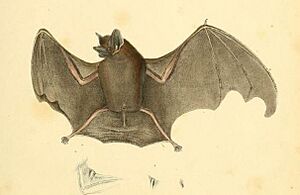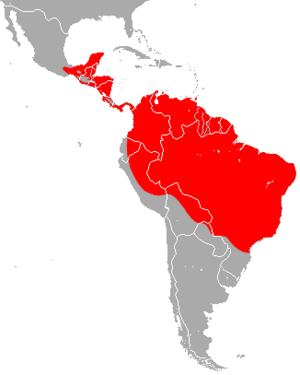Lesser dog-like bat facts for kids
Quick facts for kids Lesser dog-like bat |
|
|---|---|
 |
|
| A 1774 sketch of the species by Johann Christian Daniel von Schreber | |
| Conservation status | |
| Scientific classification | |
| Genus: |
Peropteryx
|
| Species: |
macrotis
|
 |
|
| Lesser dog-like bat range | |
| Synonyms | |
|
Vespertilio caninus Wied-Neuwied, 1826 |
|
The lesser dog-like bat (Peropteryx macrotis), also known as Peters' sac-winged bat, is a type of bat found in South and Central America. It was first described in 1826. Later, in 1843, its scientific name was changed because the original name was already being used for another animal.
About the Lesser Dog-like Bat
This bat is quite small. It measures about 6 cm (2.4 inches) from its head to its body. Its tail is tiny, only about 1.4 cm (0.55 inches) long. Adult bats weigh around 4 grams (0.14 ounces), which is very light! Female bats are usually a bit bigger than males.
The lesser dog-like bat has medium-long fur. Its fur can be brown, grey, or even reddish. It's the smallest of the bats known as "dog-like bats." Like its relatives, it has a long, hairless snout, which is why it got its common name. You can also tell it apart from other dog-like bats because it has a special pouch on its wing. This pouch opens outwards and is located on the part of the wing membrane in front of its arms.
Where Lesser Dog-like Bats Live
Lesser dog-like bats live in many places. You can find them in southern Mexico, especially in eastern Veracruz and Oaxaca. They also live all across Central America. In South America, they are found throughout Colombia. East of the Andes mountains, they reach eastern Bolivia, northern Paraguay, and Santa Catarina in Brazil.
These bats usually live in tropical forests where trees lose their leaves. They prefer areas below 1,000 meters (about 3,300 feet) in height. Sometimes, they can also be found in forests where trees stay green all year, or in dry, bushy areas. There are no different types (subspecies) of this bat that scientists recognize today. However, the Trinidad dog-like bat used to be considered a subspecies of P. macrotis.
Life and Habits of the Lesser Dog-like Bat
Lesser dog-like bats mainly eat small insects. They especially like beetles and flies. During the day, these bats usually sleep (or 'roost') in caves. They might also use human-made places like culverts (tunnels under roads), old ruins, or church roofs.
Their groups are usually small, with fewer than 15 bats. However, these bats might share their roosting spots with other types of bats. Often, there is only one male bat in a group. This male might use a special scent from his wing-sacs to attract female bats. We know that owls and big-eared woolly bats sometimes hunt and eat these bats.
These bats can have babies throughout the year. A mother bat carries her baby for about four to four-and-a-half months. Usually, a mother gives birth to just one baby at a time. The baby develops in the left side of her special uterus, which has two parts.


